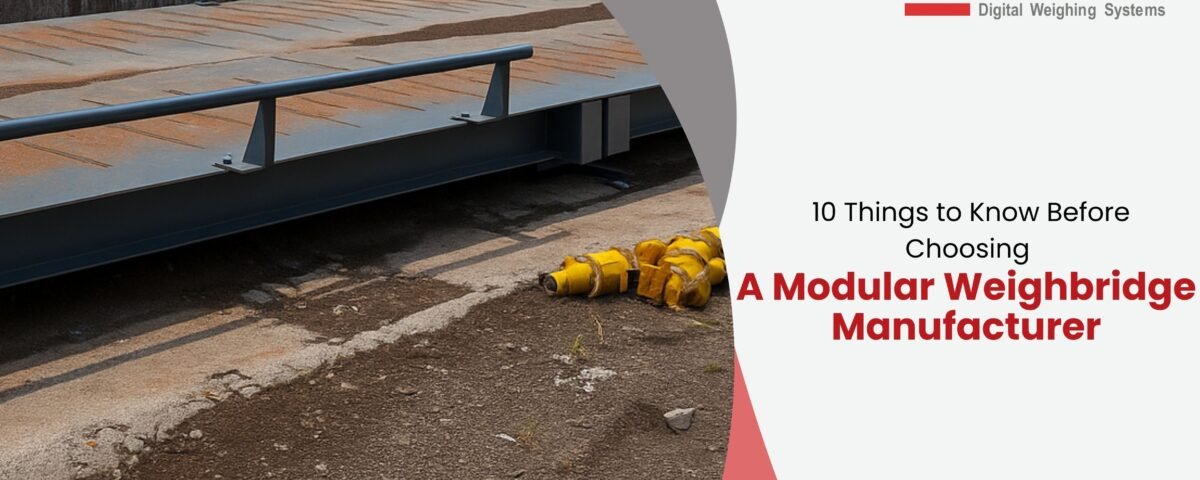10 Things to Know Before Choosing a Modular Weighbridge Manufacturer

The global weighbridge market is expected to reach $3.4 billion by 2027, yet 67% of buyers make their manufacturer selection based on price alone—a strategy that backfires spectacularly when downtime costs exceed $50,000 per day. The modular weighbridge segment, representing the fastest-growing category, demands a more sophisticated approach to vendor selection. Here’s what separates the industry leaders from the pretenders.
The Foundation Fallacy: Not All “Modular” Systems Are Created Equal
Traditional modular weighbridges require extensive concrete foundations, defeating the entire purpose of modularity. Matrix Weighing Systems‘ modular platforms “need no foundation or pit, just need a hard and plain surface to rest load cell plates”—a genuine breakthrough that reduces installation time from weeks to hours.
The best modular systems offer true plug-and-play functionality with prefabricated ramps and bottom frames that eliminate 90% of site preparation costs. When evaluating manufacturers, demand proof of foundation-free installation capabilities, not just marketing promises.
Accuracy Standards: The ±0.1% Rule That Separates Champions from Challengers
Industry-leading weighbridges achieve accuracy “within ±0.1% to ±0.5% of the total weight”, but most manufacturers hover at the lower end of this spectrum. The difference between ±0.1% and ±0.5% accuracy translates to $200,000+ in lost revenue annually for a mid-sized logistics company processing 500 trucks daily.
Top-tier manufacturers achieve superior accuracy through proprietary load cell technology and advanced signal processing. Matrix Weighing Systems’ MATRIX Intelligent Terminal (MIT) represents this precision engineering—”micro controller based high-tech state of art weighing terminal & first of its kind in India designed for weighbridge application”.
The Vertical Integration Advantage: Why End-to-End Manufacturing Matters
“The key competitive advantage of Matrix modular weighbridge is that all components like structure, Intelligent terminal, user interface, and integration are designed and manufactured by us”—a rarity in an industry dominated by assembly-line operations using third-party components.
Vertically integrated manufacturers deliver three critical advantages: consistent quality control, faster troubleshooting, and unified warranty coverage. When your weighbridge fails at 2 AM, you want one phone number to call, not a maze of subcontractor finger-pointing.
Material Science: Steel Grades That Determine Decade-Long Performance
Leading manufacturers use “A36 steel” to ensure durability and accuracy, but steel grade is just the starting point. The welding process, stress distribution design, and corrosion protection determine real-world longevity.
Key Material Specifications to Demand:
- Minimum 6mm steel deck thickness
- Hot-dip galvanized finish (not painted)
- Full-penetration welds on all load-bearing joints
- Finite element analysis documentation for stress patterns
The R&D Reality Check: Innovation vs. Marketing Theater
Matrix maintains “a dedicated R&D department” that “constantly endeavors to come up with innovative weighbridge designs that suit the changing market needs”. This isn’t standard practice—most manufacturers focus on cost-cutting rather than innovation.
Genuine R&D investment shows up in patent filings, published research, and proprietary technologies. Ask potential manufacturers for their patent portfolio and recent innovations. If they can’t produce concrete examples, they’re likely rebranding generic solutions.
Certification Theater: Why ISO Compliance Isn’t Enough
Every manufacturer claims ISO certification, but Matrix’s “ISO 9001-2008” certification represents just the baseline. Look for NTEP (National Type Evaluation Program) approval for US markets and local trade legal compliance certifications.
More importantly, demand third-party performance validation. Independent test results from certified labs carry infinitely more weight than manufacturer self-certification.
Service Network Geography: The Hidden Cost of Remote Support
A manufacturer’s service network determines your total cost of ownership more than the purchase price. Matrix’s established presence since 2006 provides the service infrastructure that fly-by-night operations can’t match.
Map your weighbridge locations against manufacturer service centers. Remote installations requiring technician flights can cost $15,000+ per service call. Factor this into your decision matrix—a slightly higher upfront cost often delivers massive long-term savings.
Customization Capability: One Size Fits None
Top manufacturers offer “an option of customization” because standard solutions rarely optimize for specific operational requirements. Your pit constraints, vehicle types, and throughput demands create unique specifications.
Evaluate manufacturers based on their engineering flexibility, not their standard product catalog. The ability to modify load cell placement, adjust platform dimensions, and integrate custom software separates true manufacturers from product resellers.
Warranty Structure: Reading Between the Legal Lines
Premium manufacturers offer “warranty of 5-15 years”, but warranty terms matter more than duration. A 15-year warranty with exclusions for “normal wear” means nothing. A 5-year comprehensive warranty covering parts, labor, and calibration provides real value.
Scrutinize warranty exclusions for environmental conditions, usage patterns, and maintenance requirements. The best warranties include regular calibration and preventive maintenance as covered services.
Technology Integration: Future-Proofing Your Investment
Modern weighbridges must integrate with ERP systems, automated gates, and vehicle identification technologies. Matrix’s MIT terminal demonstrates this forward-thinking approach with “unique features 7” high-resolution graphical interface, and advanced connectivity options.
Evaluate manufacturers based on their software ecosystem, API availability, and upgrade pathway. A weighbridge that can’t evolve with your business requirements becomes obsolete within five years.
The Strategic Decision Framework
Choosing a modular weighbridge manufacturer requires moving beyond price-based decisions to value-based evaluation. The manufacturers who survive and thrive—like Matrix Weighing Systems with their comprehensive in-house capabilities and genuine innovation focus—understand that weighbridges aren’t commodities but critical infrastructure investments.
Your manufacturer selection will determine operational efficiency, maintenance costs, and scalability for the next decade. Choose wisely, because in the weighbridge business, there are no second chances to get the foundation right.

